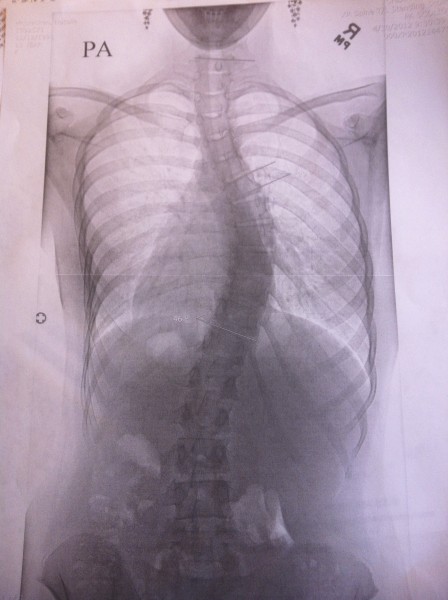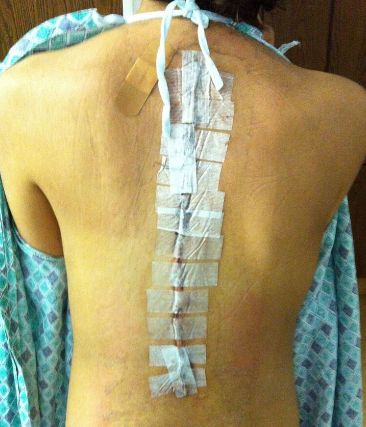
You’ve tried the alternative scoliosis treatments like exercises, yoga, and maybe even back bracing, but still the scoliosis hasn’t improved. Scoliosis surgery is not something I’d wish upon anyone but, as a last-resort treatment option, it can literally and figuratively be life saving. As I talk about in this series about treating scoliosis, my daughter went through scoliosis surgery in 2013 when her curve was over 60 degrees and continuing to progress. The doctors warned that without surgery her lung and heart could begin to be affected. Surgery not only halted the progression of her curve but it straightened her spine to a much smaller curve of 20 degrees.
If you are considering scoliosis surgery or about to have scoliosis surgery, here are some of the things you need to know (from our first-hand experience). We will cover:
- When scoliosis surgery is the right choice
- Will scoliosis surgery straighten the spine?
- Types of scoliosis surgery
- Approaches to scoliosis surgery (back or front)
- Stainless steel vs. titanium
- New methods of scoliosis surgery
When Scoliosis Surgery is the Right Choice
The decision to go with scoliosis surgery is major, and you definitely don’t want to take it lightly. Consult a scoliosis specialist. And then get a second opinion. And a third.
Scoliosis is hard to predict, so don’t be surprised if the doctors you consult give you different opinions. Some doctors recommend surgery sooner because they want to fix the problem before it gets worse. Others may determine that your child isn’t at a high risk of having the scoliosis progress, so may recommend waiting and observing. Yes, it is frustrating not knowing exactly what to do!
We consulted 3 different orthopedic surgeons for Natalie. The 1 thing they all unequivocally agreed on was that bracing would be a waste of time and 2 of them said that in some cases bracing is believed to worsen the situation. Their opinions did vary as to in which cases surgery should be considered. One doctor seemed to think that even mild curves should be surgically corrected (to prevent progression and have the straightest result possible). Others had more of a “surgery is a last resort and not something to be taken lightly” approach.
Again, each case is different and doctors will use a lot of factors to determine whether your child should have scoliosis surgery. Here is an overview of what many scoliosis experts recommend about surgery.
- Children under 3 years old (infantile scoliosis): Surgery is almost never recommended because scoliosis at this stage of life is unpredictable. Sometimes the curve can straighten itself out (though it can also get worse). So the recommendation will be observation.
- Children 3-10 years old (juvenile scoliosis): Children at these ages have a lot of growth ahead of them, and this usually means the scoliosis will get much worse. Typically, doctors recommend watching the scoliosis. When curvatures are around 25-30 degrees, then non-surgical treatments are recommended. When the curve gets to 45-50 degrees, then surgery is considered.
- Children 10-15 years of age (adolescent scoliosis): Current consensus is that surgery should be performed for scoliosis when curves are greater than 45-50 percent and growth is remaining. This is because, if growth is remaining, then the curve will likely get worse. Doctors measure the risk of the curve getting worse using methods like the Tanner staging and Risser grading. More on this below.
- Adults: Surgery is rarely given to adults with scoliosis because the curvature isn’t likely to get worse. Surgery is reserved for cases where adults are experiencing severe pain or discomfort due to the scoliosis.
The Tanner Stage and Risser Grade
To determine whether surgery is needed for scoliosis, doctors will determine whether the curvature is likely to get worse. In general, the more your child has to grow, the greater the risk of the scoliosis getting worse. This is why surgery is recommended for kids with severe curvatures (greater than 45 percent).
With teenagers, doctors use the Tanner Stage and Risser Grade to determine how much growth is left, and therefore the likelihood that the curve will get worse. Keep in mind that the score doesn’t mean that the curve will or won’t get worse. It is simply an estimate. Doctors may also consider factors like the age at menstruation, sitting and standing heights, and visual information gained from radiographs.

(Table from aafp.org)
ScoliScore
ScoliScore is a relatively new test which measures 53 genetic markers to determine whether the spinal curvature is likely to progress. This helps personalize treatment, especially when making the serious decision whether to undergo scoliosis surgery or not. We personally didn’t try the ScoliScore test, but I’d recommend it. The test is meant for children aged 9 to skeletal maturity, and with mild curvatures of 10-25%.
Apparently ScoliScore is very accurate. It assigns a value between 1 and 200. The higher the score, the more likely that the curve will progress. According to the test website, if a child has a ScoliScore of 181 or above, there is a 95% probability that the curvature will progress past 40 percent.

Will Surgery Straighten the Spine?
There are two reasons that scoliosis surgery may be performed: to stop the scoliosis from getting worse, or to straighten the spine. In the first case, the spine will not be straightened. Note that scoliosis surgery which actually straightens the spine will be more intense. The more you straighten the spine, the riskier the surgery is.
When we went for surgery, Natalie’s scoliosis was at over 60 degrees and likely would continue to progress (since she was only 14 and not done growing). One (very well regarded) surgeon said he could get her curvature down to zero (he said this when she her curve was still in the 40s). That felt very aggressive and risky, so we ultimately went with the doctor who had a better bedside manner and also had a son with scoliosis in addition to a great track record and many years of experience. At the end of the day, you have to trust your gut. Now, Natalie’s curve is down to 20 degrees and her curve is much less noticeable (she was also 1.5 inches taller after the surgery!).
According to the Scoliosis Research Society (SRS), most patients come out of scoliosis surgery with curves less than 25 degrees. How much your curve will be corrected depends on how flexible the scoliosis is before surgery. If you have a flexible curve, then it will have a greater amount of correction. There are special x-rays called “bending” or “traction films” which measure scoliosis flexibility. The SRS also says that, because your spinal bones protect your spinal cord, the surgeon can only move the bones as far as is safe.

Options for Scoliosis Surgery
As mentioned above, scoliosis surgery can have two goals: to stop the spinal curvature from getting worse, or to straighten the spine. Surgery which straightens the spine is riskier and more aggressive. However, if the scoliosis is severe (as Natalie’s was), then this may be the best option.
There are numerous different types of scoliosis surgery including: Hemi-epiphysiodesis, Hemivertebra Resection, Growth Friendly Surgery, Distraction Based, Guided Growth and Compression Based. The most common types of scoliosis are spinal fusion and spinal instrumentation. Natalie’s curvature was over 60 degrees when we went in for surgery, which is why spinal instrumentation with fusion was used.
In Situ Spinal Fusion
In Situ spinal fusion is done when the curvature is below 40 degrees, but is likely to get worse. The surgery removes the joints of the spine and replaces them with bone grafts. When the bone grafts heal, the spine will be fused together in place (in situ = in place). This type of scoliosis surgery will NOT decrease the curve, but it will stop the curve from progressing.
Spinal Instrumentation
With this surgery, instruments (such as stainless steel rods) are inserted into the spine. The instruments support the spine and correct the curvature. In most cases, instrumentation occurs with fusion – meaning that the spine joints are removed and the vertebrae are fused together with bone grafts (as our doctor explained it to Natalie: “bone croutons from a very bad motorcyclist”). If instrumentation is done without fusion, then there is a risk that the instruments will work themselves out of the back. (Source 1)
*I just wanted to note that, before Natalie had her scoliosis surgery, she donated blood several times. Basically, she created her own “blood bank” in case a transfusion was necessary during the surgery. Needing a blood transfusion is common and the safest blood to use is your own!
Approach to Scoliosis Surgery: Back or Front
Scoliosis surgery can be preformed from the back (posterior) or from the front (anterior). In most cases, the posterior approach is better and safer and this is the approach Natalie had.
The back approach to scoliosis can be done with all types of curves. To access the spine, the surgeon will have to cut up the length of the spine and cut back muscles. In some severe cases or when the curvature isn’t flexible, the surgeon may need to remove a disc from the front first. Luckily Natalie didn’t have to go through this too.
When the curve is at the thoracolumbar junction (T12-L1), then the front approach may be recommended. This involves removing a rib but does have some benefits like saving more lumbar motion. When scoliosis surgery is done from the front, a rib will need to be removed!

Stainless Steel vs. Titanium Instruments
With scoliosis surgery with instrumentation, rods or screws are put into the spine to support it and correct the curvature. The main materials used for the instruments are stainless steel and titanium. Cobalt chromium is also sometimes used.
These rods will remain in the body for the rest of your life (only about 2% of scoliosis surgery patients later have the rods removed).
And yes, sometimes they set off the metal detector at the airport. 🙂
I will let your doctor explain the pros/cons of each type of material. We ultimately decided to go with stainless steel because it is tried and true and what the doctor recommended in our case. Titanium and cobalt chromium are much newer by comparison.
New Techniques for Scoliosis Surgery
Scoliosis surgery is a major operation that comes with huge risks and requires a lot of recuperation. However, there are some new surgical procedures in the horizon. My daughter Nat had her scoliosis surgery in 2013, and the doctors didn’t recommend any of these surgeries. Even if they did, I’m not sure I would have gone with such an experimental procedure. Still, here are some options that you may want to consider or see if they are even available to you.
Spinal Tethering
This procedure was developed by Peter Newton, an orthopedic surgeon at Rady Children’s Hospital in San Diego. It is used to treat the most common type of scoliosis in which the spine curves to the right.
Tethering involves attaching a polyethylene cord with screws to the right side of the vertebrae. The idea is to restrict the spine’s growth on that side. The left side is able to grow unrestricted, hopefully pulling the spine into alignment. Once the child stops growing, the tethers are removed. According to a 2012 article, only about 20 tethering surgeries have been performed. (Source)
Vertebral Stapling
For children with spinal curvatures of 25 to 35 degrees, this may be an option. A very small incision is made in the back to insert a piece of “memory metal” into the curved area of the spine. The metal helps support the spine and also straighten it. It has a very high success rate with about 80% of patients seeing improvements or stabilization after 2 years. Vertebral stapling is possible because of the unique type of metal made from nickel-titanium alloy. When cold, it can be shaped to the exact curve of the patient. When the metal is inserted into the spine, it loses its shape and starts to straighten – straightening and supporting the spine in the process. Because the metal straightens out, it is not likely to come out of the bone. Note that this is the only type of fusion-less scoliosis surgery currently available.
Minimally Invasive Scoliosis Surgery
This option isn’t any different than traditional scoliosis surgery which fuses the spine together, with or without instrumentation. The difference is in the way it is done. Instead of making one huge cut along the spine, the procedure is done with a series of smaller incisions. The result is that healing is much faster. The downside is that the procedure does take 20-30% longer to perform than the open-back method, but your kid is going to be knocked out anyway. Only a few doctors offer this option for scoliosis surgery, including Dr. Cheng and Dr. Eichholz at Vanderbilt Medical Center. (Source)
Getting Ready for Scoliosis Surgery
If you are reading this, then you are probably still deciding whether or not to go with scoliosis surgery. For those of you who ultimately do decide that surgery is the best solution for your scoliosis, I recommend that you take a lot of time to prepare for the surgery — both mentally and physically. You can read about our experiences and tips in this post about preparing for scoliosis surgery and recovering from scoliosis surgery.
Have you or your child undergone scoliosis surgery? Let us know your experiences and advice!
Want more information on scoliosis? Download my eBook for information on what causes scoliosis, how to manage it, and treatment options. You can buy it here.

Latest posts by Sylvie McCracken (see all)
- Treating H. Pylori (Part 3): What H. Pylori Does to the Body - August 8, 2022
- Treating H. Pylori (Part 2): How H. Pylori is Contracted - August 3, 2022
- Understanding Beef Labels: Organic, Pastured, Grass-Fed & Grain-Finished - July 25, 2022
